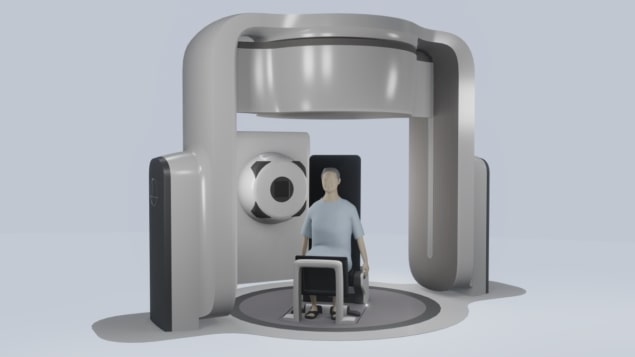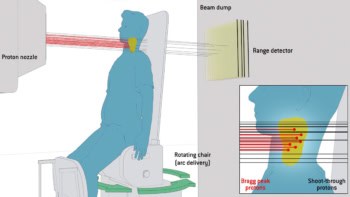
As new and improved radiotherapy technologies emerge, treatment conformality – the level of dose delivered to the tumour target and not to the rest of the body – increases alongside. For photon-based radiotherapy, for example, the development of intensity-modulated radiotherapy (IMRT) and the recent introduction of MR-guided systems has ramped this conformality. In proton therapy, meanwhile, the shift to pencil-beam scanning had a similar beneficial effect.
But since the early 2000s, progress in proton therapy has stalled somewhat. In particular, there’s still a general lack of the high-quality image guidance that’s available for photons. “Protons are up to three times more expensive in terms of cost, time and manpower, but reimbursement is only 1.3 times; and that is the reason that the proton space has flatlined,” says Niek Schreuder, president of proton therapy at Leo Cancer Care. “There’s just no R&D money in existing proton therapy facilities.”
Schreuder points out that various technologies with potential to enhance proton and other particle therapies are under development and shown to be feasible. These include, for example, prompt gamma measurements for range verification, proton radiography, dual-energy CT and optical guidance. But the large size of particle therapy gantries and the lack of space around the isocentre makes installing image-guidance technologies extremely difficult.
Upright approach
The solution, says Schreuder, is upright radiotherapy, where the patient is treated in an upright position and rotated in front of a static treatment beam. Upright treatment systems have lower installation costs and space requirements, freeing up resources for technology developments. “It also provides more comfortable treatment positions for patients with pulmonary problems, pain or claustrophobia issues,” he adds.
As such, Leo Cancer Care is developing a range of products to enable this novel treatment approach, including an automated patient positioning system. “All radiation treatments include two parallel processes – patient positioning and beam delivery,” explains Schreuder. “95% of the treatment time involves patient positioning, but up to now, in proton therapy, less than 10% of the system cost goes into patient positioning.”
To address this shortfall, the company is developing software that incorporates all of the imaging technologies used to position the patient into one user interface, with a treatment room control system focused on the systems needed to position the patient. “Of course, beam control is super important,” Schreuder adds, “but we argue that beam control has been developed to such a level of maturity that, as a company, we don’t have to worry much about this part.”
The positioning system can place the patient in appropriate postures according to the cancer type being treated. This includes, for example, seated vertical for head-and-neck treatments, with gravity pulling the shoulders naturally downward to better expose the head nodes; leaning slightly backward for lung and liver radiotherapy and slightly forward for breast cases; or perched, supported by the back of the thigh and a knee rest, for prostate and pelvic treatments.
Previously, all of these cases were treated the same, with the patient lying down, explains CEO Stephen Towe. “What we’re doing, for the first time, is using patient posture as a degree-of-freedom to truly optimize treatment delivery,” he says. “This is the first time that the radiation therapy problem is being addressed by starting at what the patient needs to be treated optimally and more comfortably.”
The company has also developed a vertical dual-energy CT scanner coordinated with the upright positioning system that scans the patient in any of these orientations and can perform a dual-energy scan in less than one minute. The idea is that the two devices will be placed together in a fixed-beam treatment room, within an existing proton or carbon-ion therapy facility, for example. Treatment is delivered by rotating the patient in the beam, rather than rotating a large gantry.
A major advantage of this approach is the reduced shielding requirements. If radiation is being delivered through 360°, this requires 360° of shielding. If the radiation is only sent in one direction, it’s possible to significantly reduce the room size and costs. It also reduces design complexity, which is particularly vital for developing markets, where expertise to design radiation shielding rooms may not be available.
Schreuder points out that, compared with a classical rotating proton gantry, an upright fixed-beam setup requires around 19 times less shielded volume. Even with a superconducting gantry, the shielding requirements are about 10 times less for the fixed proton beam. Ultimately, this could allow installation of a proton therapy system in an existing linac vault.
“The weight of a radiotherapy system ranges from six up to 600 tonnes for a carbon ion facility,” adds Towe. “Trying to rotate that mass around the patient with an accuracy of less than 1 mm makes no sense. It’s like changing a lightbulb by rotating your house.”
Clinical benefits
Rock Mackie, board chairman and co-founder of Leo Cancer Care, says that it’s not just a matter of cost, but that upright radiotherapy also confers some important clinical benefits. A study looking at thoracic cancer patients, for instance, showed that lung volume was on average 25% greater with upright rather than horizontal positioning, which reduces breathing motion. This is because the lung is more inflated as gravity pulls the diaphragm down. This could prove particularly useful for scanned proton treatments where motion can cause interplay effects, explains Mackie.
Reducing patient motion could also remove the need for motion management, making the treatment much faster. And where breath holds are required, these are easier for patients to perform when upright. A more inflated lung also reduces the dose to normal lung for proton therapy.
The team is also studying the impact of positioning on prostate motion. They saw that when a patient is upright, the level of bladder filling does not impact prostate position as it does when they are lying down, which is a huge benefit. “We started by focusing on making patients more comfortable, and this resulted in something that’s really clinically significant, the reduction in motion that comes from being positioned upright,” says Towe.
Leo Cancer Care is now working with proton therapy vendors to integrate the Leo technologies into existing fixed beam rooms and with one vendor to install its first system in a new proton therapy facility that will start construction at the end of this year. The company is also building a compact self-shielded linac for upright photon-based radiotherapy, which incorporates the positioning device and CT scanner. All systems should achieve FDA approval and CE marking by the end of 2021.
“There’s a problem that needs to be solved right now in the proton therapy space by reducing cost,” adds Schreuder. “Our approach could lead to more proton therapy systems across the world. And as a result of the huge reduction in the total facility costs, we believe that these facilities will have the financial means to support R&D projects to further develop many other aspects of proton beam delivery with endless benefits to patients.”



